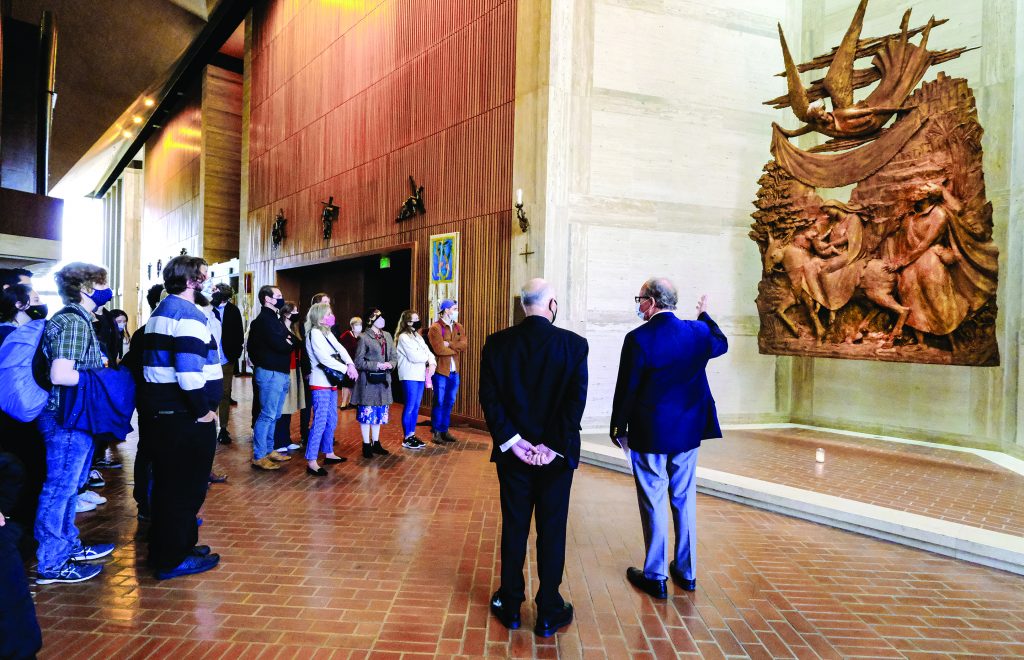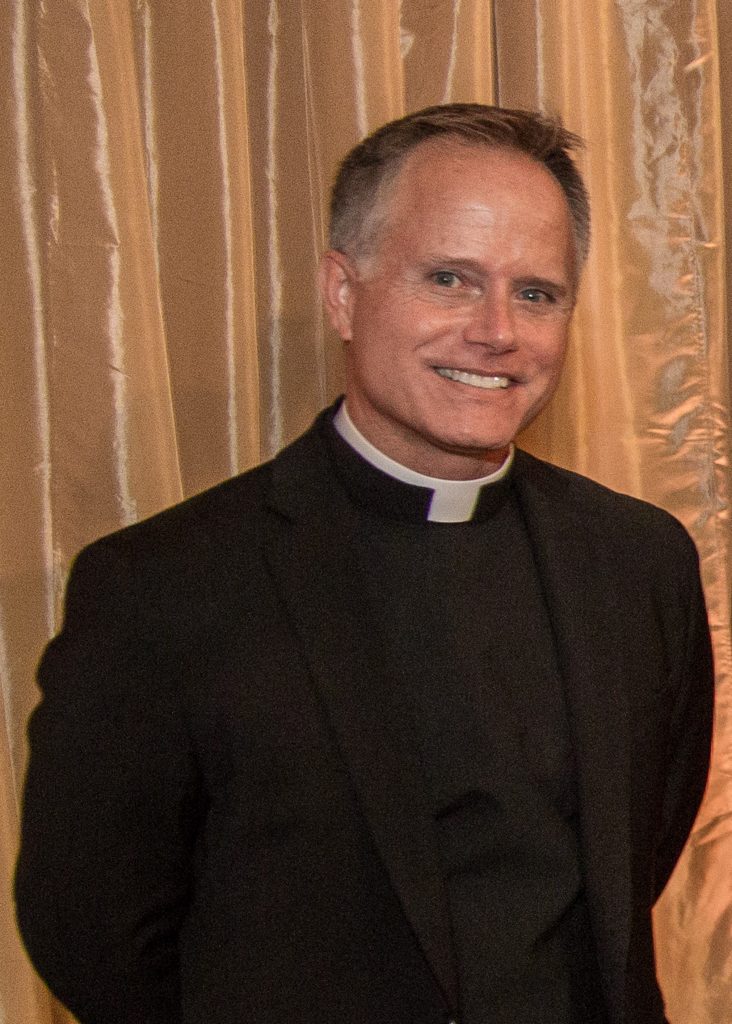History: Council Creation
Spirit of Vatican II expressed “perfectly” at St. Mary’s Cathedral
By Christina Gray
Lead writer, Catholic San Francisco
Looking up into the modern “rafters” of St. Mary’s Cathedral 50 years after it was dedicated, San Francisco Archbishop Salvatore J. Cordileone marveled at the structure designed and constructed by chance in the years following the meeting of the Second Vatican Council from 1962-65.
“It’s bold, it’s imaginative and it perfectly expresses what the Church has been discerning for a long time now, since the world moved into this modern era,” the archbishop said in the video produced by the cathedral in 2021, its anniversary year. “How can the Church better communicate the timeless eternal truth of the Gospel in the world that we are living in today?”

St. Mary’s Cathedral is the first cathedral in the world built after Vatican II. It is a monument of sorts to the vision of council fathers, who called for a renewal of certain church traditions and liturgical practices in order to help the Church better maintain relevance to the increasingly secular world around it.
The cathedral’s dramatic vertical ceiling “encapsulates that vision,” said Archbishop Cordileone. He noted that the architecture “sweeps us up into heaven,” but is also horizontal, with windows offering a clear-eyed union with the urban landscape outside.
“This is how the Church needs to live and evangelize in the world today,” he said. “Keeping always our vision fixed on heaven, but looking around, reading the signs of the times. The council told us to do to this in order to better engage the world and draw people into encounter with Christ.”
AN OPPORTUNITY FOR “GREATNESS”
The 1960s began as a period of unprecedented tranquility and growth in the Catholic Church, according to a self-published book on St. Mary’s Cathedral sold in the downstairs gift shop. In the Archdiocese of San Francisco, Catholic schools were fully enrolled. Nationally, convents and seminaries were full and the first Catholic president, John Fitzgerald Kennedy, was elected. During this same decade, the Second Vatican Council brought about remarkable changes in Catholic life and worship.
After the destruction of the cathedral on Van Ness Avenue in 1962, newly installed Archbishop Joseph T. McGucken began unfolding plans for a new St. Mary’s Cathedral. Three local architects were chosen. Angus McSweeney, Paul A. Ryan and John Michael Lee produced traditional designs that ranged from traditional Romanesque to California mission-style. The designs were critiqued by some as missing the mark in embodying the liturgical changes wrought by Vatican II.
Even the secular media made note of the missed opportunity for “greatness.”

“The cathedral must belong to its own people and place, but also to the world,” wrote Alan Temko, prize-winning architectural critic for the San Francisco Chronicle in 1963. “It must express the oneness of things, as well as their ineffable mystery.”
Msgr. John Talesfore is pastor of St. Matthew Parish in San Mateo. As rector of the cathedral from 2005-2015 and a former architecture student himself, he said that during this same period of time, fortuitously, a very influential international liturgical organization was meeting in Berkeley.
“These were people who were looking at all the art and architecture that serves worship to really call forth excellence and what is true and good and beautiful,” he said. “Not to just do a poor imitation of old things, but really bring out the genius of living artists and architects to provide what the liturgy truly needs now.”
Among that society was a Benedictine monk named Father Godfrey Diekmann, who agreed with Temko’s article and requested a meeting with Archbishop McGucken.
“He advised him to go back to square one,” said Msgr. Talesfore, and create a cathedral in the spirit of Vatican II.
Archbishop McGucken seized the day. At his advisers’ recommendation, he approached the innovative Pietro Belluschi, dean of the Massachusetts Institute of Technology School of Architecture, to lead the team.
Belluschi was reluctant to accept the commission but did.
“From the beginning, we were aware that this is not an age of cathedral building,” he wrote. “Yet the yearning for spiritual goals is still a powerful force seeking expression.” Architects, he said, are too often engaged in “building symbols of commerce.”
Belluschi acknowledged that the design and construction of a 20th-century cathedral, fully expressive of modern times, in one of the most earthquake-prone, architecturally conscious cities in the world was a daunting prospect.
Archbishop McGucken encouraged Belluschi to design the cathedral with three major considerations: That the church would stand tall as a beacon to the modern world on the San Francisco skyline; that it should seat a large number of people, since it would function as the center of archdiocesan and civic events; and that it should wrap the congregation around the altar to help them become an integral part of the liturgy.
Belluschi based his designs on the belief that there should be a strong structural concept and an engineering form expressive of the modern age and comparable in size and scale to cathedrals of the past but using contemporary technologies. He recommended that Pier Luigi Nervi be retained as an engineering design consultant.
Nervi, an expert in reinforced and pre-stressed concrete, found the structural resolution to Belluschi’s hyperbolic paraboloid design, a creative use of curves and lines that did not obstruct from the altar.
“The legend is that Nervi’s wife was bedridden,” Msgr. Talesfore said. “While sitting with her, he felt the cross of her rosary under the bedsheet, the cross laying horizontally on the sheet much like how the ceiling of St. Mary’s Cathedral falls.”
NOT WITHOUT CONTROVERSY
According to an account in Volume 3 of the History of the Archdiocese of San Francisco, written by former archdiocesan archivist Jeffrey M. Burns, Archbishop McGucken was in Rome participating in the Second Vatican Council meeting when the first model of the new cathedral was brought to him.
“As soon as I saw it, I was startled, I never imagined anything like that,” the archbishop later recalled. “My first thought was, ‘How am I going to talk them out of this?’”
As a testament to his convictions and confidence in this design team, the archbishop “began to see it differently” as the plans evolved, and then grew enthusiastic.
A series of press conferences, held in 1964, presented the strikingly modern design. It was met (mostly) by praise.
“This is the first cathedral truly of our time and in harmony with the liturgical reforms of the council,” said Nervi at the time. Ground was broken in August 1965.
Some Catholics indeed expressed discomfort with the ultramodern design of the cathedral. It earned some humorous nicknames, including Our Lady of Maytag, from those who thought it resembled a washing machine agitator.
The ‘60s civil rights movement and President Lyndon Johnson’s War on Poverty coincided with the beginning of construction, and many Catholics expressed concern that too much money was being spent that could otherwise go to the poor.
In June 1966, the Mid-Peninsula Catholic Interracial Council picketed Archbishop McGucken at the annual ordination of priests, criticizing the erection of “a lavish cathedral” overlooking “some of the worst slums of San Francisco.” A year later, 27 archdiocesan priests staged a public protest urging the archbishop to redirect the money to the poor.
CATHEDRAL “SINGS A SONG OF PRAISE”
Construction continued nonetheless. St. Mary’s Cathedral opened its marvelous bronze doors in 1971 at a cost of $9 million. The full cathedral complex includes a massive Event Center downstairs, with a wealth of meeting rooms and halls for rent, and a gift shop. The building also includes the archbishop’s residence and rectory.
When the cathedral was dedicated on Dec. 10, 1996, nearly 25 years later, many more Catholics had come to appreciate the extraordinary grace and beauty of St. Mary’s Cathedral.
The entire building “sings a song of praise,” according to Sister Michaela O’Connor, a Sister of the Holy Family who served all three St. Mary’s Cathedrals. She was the current cathedral’s first sacristan.
“This whole building is an act of worship,” she said in the same anniversary video. The concrete pylons are held upward, like the arms of the priest as he raises his arms to pray with the community. “It’s a cry of joy from creation for anyone that comes in the door.”

